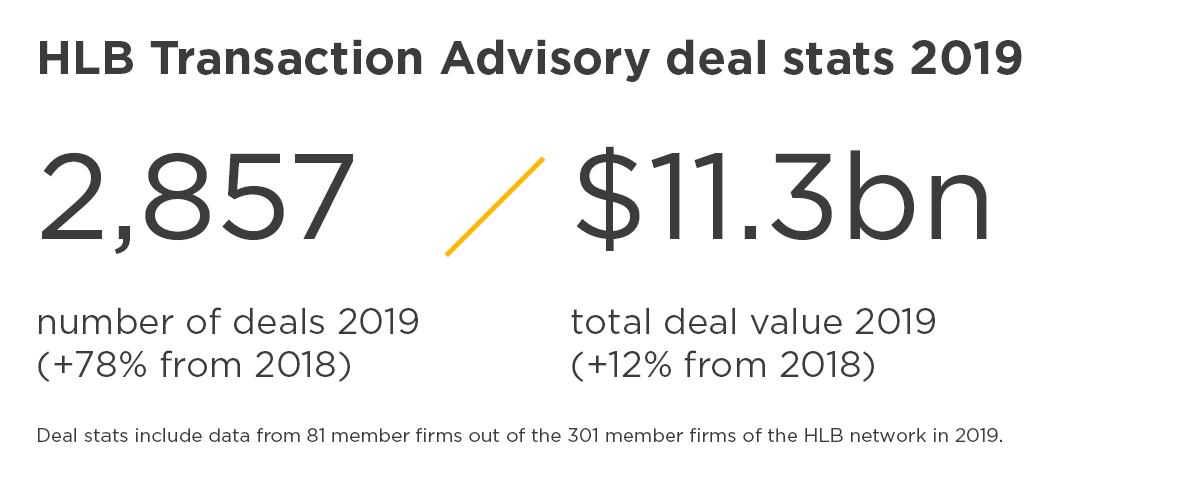Transactions Outlook 2020
An Overview of M&A Trends across Regions
Despite political and economic uncertainty, the global M&A market remained resilient in 2019. Will the market hold in 2020? And what trends can we expect the see in transactions across different regions and sectors?
A complex array of factors influenced the M&A market over the last twelve months and will continue to do so. With US elections looming in November, and the finer details of Brexit still to be worked out, 2020 promises to be as unpredictable as 2019.
Levels of private equity investment remained high in 2019, and there’s no reason to believe that PE firms will lose their appetite for investment. However, the rate of cross‐border deals has slowed globally and will continue to do so, with the US market in particular, turning inward.
Two trends that defined the M&A market in 2019 will undoubtedly continue into 2020. Firstly, the drive to build scale will continue to drive the M&A sector in 2020. Secondly, tech will continue to be a popular investment choice in 2020, creating new opportunities for M&A. As companies work to keep pace with technological change, many will opt to merge with or acquire tech firms, rather than develop new technologies in‐house.
The coronavirus outbreak has made global headlines in recent weeks and may likely affect investor confidence, as the implications of the outbreak are weighing heavily on global supply chains.
Besides factors influencing the global market, what kind of M&A trends can we expect to see across regions in 2020? Our Transactions Advisory team shares their expectations by region, as we take a closer look at local and sector specific trends.
North America
The North American M&A market remained strong in 2019. Deal valuations held steady and public companies and private equity investors remained aggressive in their pursuit of high‐quality private companies aligned with their strategic and investment objectives. Favourable borrowing conditions from lenders continued, with debt utilisation still high but falling slightly in Q3.
The industrial, manufacturing and software sectors all performed well. Companies with less exposure to tariffs or the economic cycle have been particularly attractive to private equity buyers. There was also some pullback in construction and oil & gas activity in the second half of 2019.
Despite a new trade deal between the USA and China, concerns related to the trade conflict are expected to continue in 2020. This year also sees a US Presidential election which will likely result in some tentative investing during the second half of the calendar year as the race intensifies.
Capital still remains relatively cheap and attainable. The yield curve has reversed in recent months, and there is no longer a sense that a recession in the USA is inevitable. Increasingly there are more independent sponsors and family offices entering the market. Smaller investors have the advantage of being more nimble and are generally able to take control of an investment indefinitely.
Anant Patel, Global Transactions Advisory Leader: “Typically, I would have expected more companies to try to close end of 2019 or Q1 2020, as often an election year is a bit of a pause button due to the uncertainty it brings. However, there seems to be less of a concern this time around. There doesn’t seem to be any slippage or shortage of interest in the M&A market. Where I thought 2020 would be a softer year, and it may still prove to be correct, so far it doesn’t appear to be the case as I speak to others in the sector. In Q4 of 2019 we did see an increased level and depth of due diligence on transactions by the buyers. This does suggest that buyers who appear still be have a large appetite to close deals are spending more time to ensure they are comfortable with the acquisitions”
While the European economy is weakening, in North America tax cuts – and a relatively strong US economy – strengthened the 2019 deals market. While Brexit has yet to have much impact on the North American markets, we would expect there to be continued unease regarding cross‐border deals involving North American companies interested in transactions involving entities in the United Kingdom.

Europe
The European M&A market held steady in 2019, with a moderate increase in the number of deals. A slight decrease is forecast for 2020, owing to the general economic climate, and fewer corporate deals. History has shown that when debt decreases, M&A loses momentum.
Traditional industries, such as construction and services, showed growth in 2019, and these sectors, alongside food, recycling and compliance are anticipated to perform well in 2020. ICT has also grown in importance – however, the sector’s project driven business models are not attractive to companies looking to make long‐term investments.
Across the sector, companies are reviewing their business models and trying to add more recurring business, as opposed to project‐based work.
Smaller, more niche investors, are likely to fare better than middle‐size firms ‐ which are at risk from larger competitors. Private equity firms in particular have a lot of money that they need to invest in order to maintain their overall returns and performance levels, so they will always be important buyers.
Generally, buyers have become more forward thinking in recent years. This is particularly the case in matters of due diligence, with buyers taking care to ensure their investments will remain profitable. This includes focus on ‘normalised’ earnings which is an increasing focus of diligence efforts on both sides of a transaction.
Across Europe, M&A remains a seller’s market. Supply is lower than demand, and this is expected to remain the case in 2020. Consolidation is taking place in several sectors, with mid‐market investors buying smaller competitors in order to survive.
Asia‐Pacific
Just weeks into the new year the coronavirus outbreak in China created unforeseen challenges for dealmakers in Asia-Pacific and possibly the rest of the world, as the virus continues to spread. So far, the impact of the virus is weighing heaviest on supply chains and workforce, affecting investor confidence. Optimists believe however that M&A activity will remain resilient as volatility can create opportunity in certain sectors.
The Asia‐Pacific M&A market has witnessed a resurgence in private equity investment, with a record $2.2 billion invested in PE in 2019. Buyers continued to pick up assets in lower multiples ‐ and good opportunities were snapped up quickly. Political uncertainty, in particular the ongoing trade dispute between the US and China, will continue to affect the M&A market in the region.
In Australia, however, the political climate has stabilised, thanks to last year’s election. The Australian government is likely to invest in infrastructure projects, in particular in the water and power sectors. Flood management, irrigation, power and hydro‐power are going to be serious investment trends in the future, and we expect to see the water, power and utilities sectors grow. This includes green industries such as solar and wind investments, as well as green tech such as electric cars and the infrastructures required to support them.
M&A remains a seller’s market at the higher end and the market. Increasingly, money is being pumped into the private equity sector. The sector is dominated by a number of big funds that have to spend money in order to make money. At the smaller end, M&A is increasingly a buyer’s market. Baby boomers are being replaced by a less entrepreneurial generation who are keen to sell their parents’ businesses. Baby boomers aren’t super tech savvy and they may choose to sell, rather than keep up with technology to compete This could put things in the buyer’s favour.
Latin America
The Latin American M&A market continued to grow in 2019, both structurally and quantitatively. This was despite challenges, including lower than expected economic growth, delays in some expected reforms, and instability in international markets. However, the number of deals increased in 2019, and there is every reason to feel optimistic about 2020.
2019 can be considered a very important year from a macroeconomic point of view. In Brazil – South America’s largest economy ‐ the government’s flagship Social Security Reform was approved, and the government created a positive agenda for controlling public spending.
In addition, inflation is at last under control. This has contributed to a sustained downward cycle of interest rates that reached historical lows. Consequently, the famous ‘crowding out effect’ is diminishing and the private sector is growing stronger. The effects could be observed in the second half of the year, when Brazilian risk premiums reached record low levels and GDP increased. Additionally, a number of privatisations were completed successfully, and there was an increase in the availability of private equity and venture capital funds. Economic agents are becoming more optimistic.
Brazil led Latin America in the number of transactions, with more than four times the number of transactions compared to Mexico. Chile and Colombia each were home to approximately 10% of deals. The majority of investors were from within Latin America in higher numbers than in the previous years in terms of transactions, but foreign investors – particularly from US, Japan, Germany, France and Britain – still played an important role.
Financial investors were responsible for around 25% of total deals in 2019, and it is possible this rate will increase in 2020. We expect that the sectors in the foreground in 2019 ‐ technology, financial services, infrastructure (including energy), real estate, agribusiness as well as health, industrial and retail ‐ will continue trending in 2020.
In Latin America, M&A remains a seller’s market, driven by succession, competition, growth, recovery, divesting noncore assets or opportunity. 2020 is likely to be a very positive year for M&A in Latin America, though political or international market risks may frustrate our expectations. Strategic players and private equities should announce a greater number of more robustly valued deals than in 2019.
Africa & Middle East
In Africa, M&A is a sellers’ market. The continent is an attractive destination for investors in general and is home to a growing middle class. The macroeconomic and political situations are improving, and investors are increasingly looking to buy into Africa.
In the last few years, the pace of M&A transactions in Africa has been slow. Private equity has seen some challenges. Some funds have had trouble exiting some of their transactions, and fundraising has been more difficult than it used to be. However, a lot of new capital is flowing in and trade finance is exceptionally strong.
As a whole, the African M&A sector is extraordinarily diverse, and investors will find conditions vary greatly from country to country. The aggregated demand is around energy and mining, larger tickets that tend to lead in value. In terms of number of transactions, the largest sectors are financial services and agriculture. Investments in agriculture tend to focus on agri‐processing and agri‐logistics, more than traditional agriculture.
Investors are varied, and throughout the continent we are seeing a lot more diversification in investor demand. The largest M&A funds are managed in Africa itself, allowing investors to be close to the opportunities. Key routes between capital in London and Paris are being maintained as well. There is an increasing demand from the Middle and Far East as well as they are looking to enter the market, particularly in the area of finance.
Kenya, East Africa’s largest economy, attracts two‐thirds of M&A activity. Uganda, Ethiopia and Tanzania are increasingly attracting investment. Out of all African markets, Nigeria is the most attractive venue for investors because of the sheer size of its economy. The west African countries of Ghana, Senegal and Cote d’Ivoire have some of the fastest growth rates in the world, and are increasingly attracting attention from investors. In North Africa, Morocco and Egypt are becoming increasingly attractive, thanks to political and economic reforms.
There is a lot of interest in intra‐African M&A because many companies want consolidation and to build scale ‐ especially in the financial sector. We expect this to increase in the years ahead.
Further discussion
Despite general economic uncertainty, the world economy is in reasonable health. Interest rates are low and there is plenty of capital available. These are positive indicators that M&A activity will generally remain strong. To discuss any of the topics raised in this article or learn more about local or sector specific trends, contact our Transaction Advisory team.



